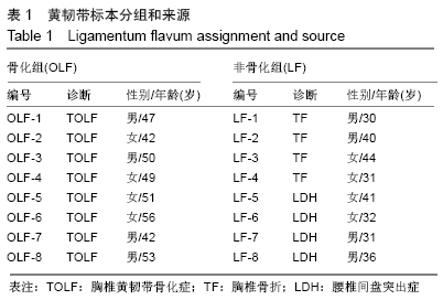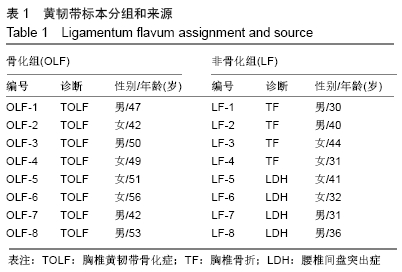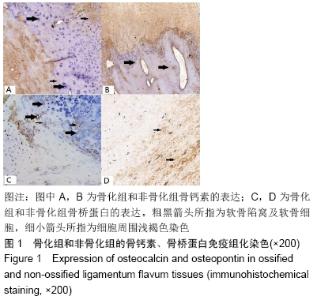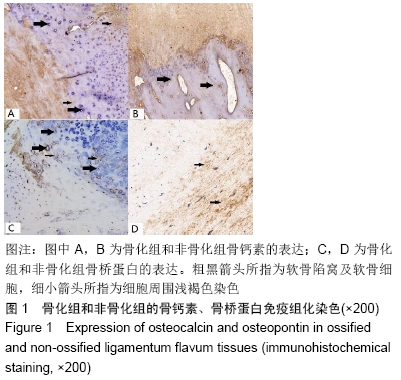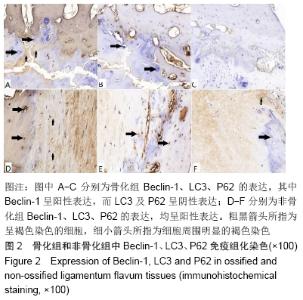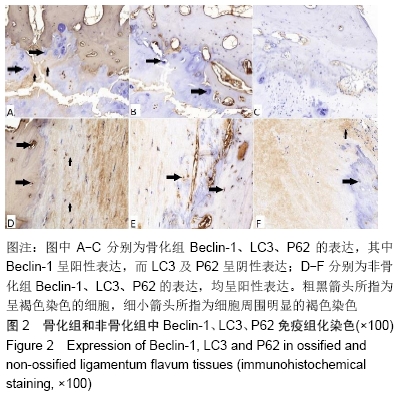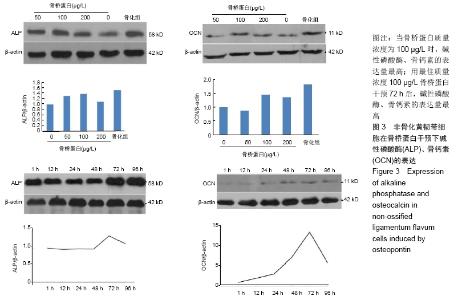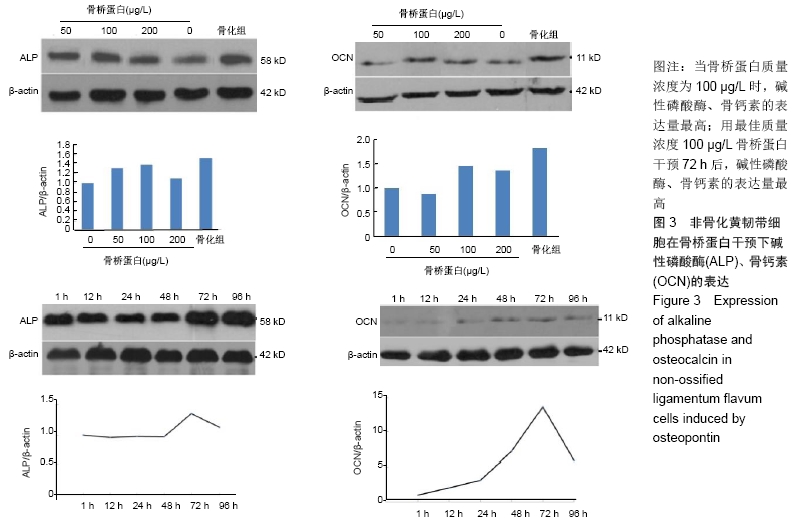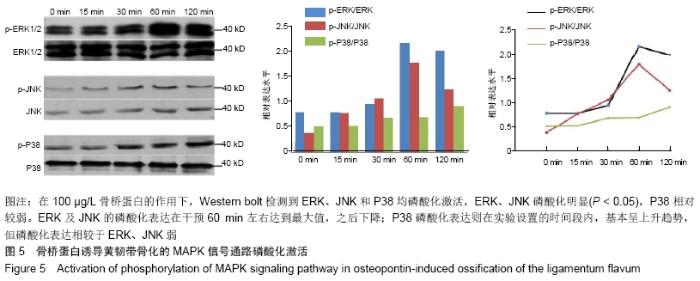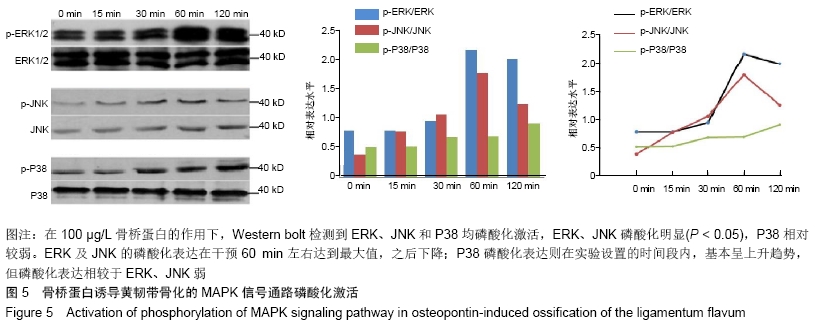Chinese Journal of Tissue Engineering Research ›› 2020, Vol. 24 ›› Issue (8): 1174-1181.doi: 10.3969/j.issn.2095-4344.2497
Previous Articles Next Articles
The role of autophagy in ossification of the human ligamentum flavum
Xu Guofeng, Li Xuebin, Tang Yifan, Zhao Yin, Zhou Shengyuan, Chen Xiongsheng, Jia Lianshun
- Spine Center, Hospital of Orthopedics, Shanghai Changzheng Hospital, Second Military Medical University, Shanghai 200003, China
-
Received:2019-07-10Revised:2019-07-16Accepted:2019-08-21Online:2020-03-18Published:2020-01-21 -
Contact:Chen Xiongsheng, MD, PhD, Chief physician, Professor, Doctoral supervisor, Spine Center, Hospital of Orthopedics, Shanghai Changzheng Hospital, Second Military Medical University, Shanghai 200003, China -
About author:Xu Guofeng, Master, Physician, Spine Center, Hospital of Orthopedics, Shanghai Changzheng Hospital, Second Military Medical University, Shanghai 200003, China -
Supported by:the National Natural Science Foundation of China (General Program), No. 81171753; the Project of Science and Technology Commission of Shanghai, No. 15140903800
CLC Number:
Cite this article
Xu Guofeng, Li Xuebin, Tang Yifan, Zhao Yin, Zhou Shengyuan, Chen Xiongsheng, Jia Lianshun. The role of autophagy in ossification of the human ligamentum flavum[J]. Chinese Journal of Tissue Engineering Research, 2020, 24(8): 1174-1181.
share this article
| [1] EPSTEIN NE. Ossification of the yellow ligament and spondylosis and/or ossification of the posterior longitudinal ligament of the thoracic and lumbar spine. J Spinal Disord. 1999;12(3):250-256. [2] GUO JJ, LUK KD, KARPPINEN J, et al. Prevalence, distribution, and morphology of ossification of the ligamentum flavum: a population study of one thousand seven hundred thirty-six magnetic resonance imaging scans. Spine (Phila Pa 1976). 2010;35(1):51-56. [3] INAMASU J, GUIOT BH. A review of factors predictive of surgical outcome for ossification of the ligamentum flavum of the thoracic spine. J Neurosurg Spine. 2006;5(2):133-139. [4] QU X, CHEN Z, FAN D, et al. Notch signaling pathways in human thoracic ossification of the ligamentum flavum. J Orthop Res. 2016;34(8):1481-1491. [5] JUNAID A, MOON MC, HARDING GE, et al. Osteopontin localizes to the nucleus of 293 cells and associates with polo-like kinase-1. Am J Physiol Cell Physiol. 2007;292(2): C919-926. [6] MORINOBU M, ISHIJIMA M, RITTLING SR, et al. Osteopontin expression in osteoblasts and osteocytes during bone formation under mechanical stress in the calvarial suture in vivo. J Bone Miner Res. 2003;18(9):1706-1715. [7] BOULEFTOUR W, BOUET G, GRANITO RN, et al. Blocking the expression of both bone sialoprotein (BSP) and osteopontin (OPN) impairs the anabolic action of PTH in mouse calvaria bone. J Cell Physiol. 2015;230(3):568-577. [8] WONGKHANTEE S, YONGCHAITRAKUL T, PAVASANT P. Mechanical stress induces osteopontin expression in human periodontal ligament cells through rho kinase. J Periodontol. 2007;78(6):1113-1119. [9] ZAHM AM, BOHENSKY J, ADAMS CS, et al. Bone cell autophagy is regulated by environmental factors. Cells Tissues Organs. 2011;194(2-4):274-278. [10] DANCOURT J, MELIA TJ. Lipidation of the autophagy proteins LC3 and GABARAP is a membrane-curvature dependent process. Autophagy. 2014;10(8):1470-1471. [11] YANG Z, KLIONSKY DJ. An overview of the molecular mechanism of autophagy. Curr Top Microbiol Immunol. 2009; 335:1-32. [12] BARTH S, GLICK D, MACLEOD KF. Autophagy: assays and artifacts. J Pathol. 2010;221(2):117-124. [13] MIZUSHIMA N, YOSHIMORI T, LEVINE B. Methods in mammalian autophagy research. Cell. 2010;140(3):313-326. [14] KLIONSKY DJ, EMR SD. Autophagy as a regulated pathway of cellular degradation. Science. 2000;290(5497):1717-1721. [15] FURUYA N, YU J, BYFIELD M, et al. The evolutionarily conserved domain of Beclin 1 is required for Vps34 binding, autophagy and tumor suppressor function. Autophagy. 2005; 1(1):46-52. [16] INOUE H, SEICHI A, KIMURA A, et al. Multiple-level ossification of the ligamentum flavum in the cervical spine combined with calcification of the cervical ligamentum flavum and posterior atlanto-axial membrane. Eur Spine J. 2013;22 Suppl 3:S416-20. [17] 李学斌,许政,周盛源,等.丝裂原活化蛋白激酶信号通路在骨桥蛋白介导黄韧带骨化中的作用[J].中国组织工程研究, 2017, 21(28):4469-4474. [18] FAN D, CHEN Z, CHEN Y, et al. Mechanistic roles of leptin in osteogenic stimulation in thoracic ligament flavum cells. J Biol Chem. 2007;282(41):29958-29966. [19] CAI HX, YAYAMA T, UCHIDA K, et al. Cyclic tensile strain facilitates the ossification of ligamentum flavum through β-catenin signaling pathway: in vitro analysis. Spine (Phila Pa 1976). 2012;37(11):E639-646. [20] MIKAWA Y, HAMAGAMI H, SHIKATA J, et al. Elastin in the human intervertebral disk. A histological and biochemical study comparing it with elastin in the human yellow ligament. Arch Orthop Trauma Surg. 1986;105(6):343-349. [21] ZAKI SM. Study of the human ligamentum flavum in old age: a histological and morphometric study. Folia Morphol (Warsz). 2014;73(4):492-499. [22] SHUNZHI Y, ZHONGHAI L, NING Y. Mechanical stress affects the osteogenic differentiation of human ligamentum flavum cells via the BMP‑Smad1 signaling pathway. Mol Med Rep. 2017;16(5):7692-7698. [23] YANG X, CHEN Z, MENG X, et al. Angiopoietin-2 promotes osteogenic differentiation of thoracic ligamentum flavum cells via modulating the Notch signaling pathway. PLoS One. 2018; 13(12):e0209300. [24] CHAO YH, HUANG SY, YANG RC, et al. Tissue transglutaminase is involved in mechanical load-induced osteogenic differentiation of human ligamentum flavum cells. Connect Tissue Res. 2016;57(4):307-318. [25] NING S, CHEN Z, FAN D, et al. Genetic differences in osteogenic differentiation potency in the thoracic ossification of the ligamentum flavum under cyclic mechanical stress. Int J Mol Med. 2017;39(1):135-143. [26] SAIRYO K, BIYANI A, GOEL V, et al. Pathomechanism of ligamentum flavum hypertrophy: a multidisciplinary investigation based on clinical, biomechanical, histologic, and biologic assessments. Spine (Phila Pa 1976). 2005;30(23): 2649-2656. [27] YIN X, CHEN Z, GUO Z, et al. Tissue transglutaminase expression and activity in human ligamentum flavum cells derived from thoracic ossification of ligamentum flavum. Spine (Phila Pa 1976). 2010;35(20):E1018-1024. [28] LIU Y, ZHAO Y, CHEN Y, et al. RUNX2 polymorphisms associated with OPLL and OLF in the Han population. Clin Orthop Relat Res. 2010;468(12):3333-3341. [29] ZHONG ZM, CHEN JT, ZHANG Y, et al. Growth/differentiation factor-5 induces osteogenic differentiation of human ligamentum flavum cells through activation of ERK1/2 and p38 MAPK. Cell Physiol Biochem. 2010;26(2):179-186. [30] ZHANG C, CHEN Z, MENG X, et al. The involvement and possible mechanism of pro-inflammatory tumor necrosis factor alpha (TNF-α) in thoracic ossification of the ligamentum flavum. PLoS One. 2017;12(6):e0178986. [31] 杨晓曦,陈仲强.胸椎黄韧带骨化易感基因及蛋白质组学研究进展[J].中国脊柱脊髓杂志,2018,28(6):562-566. [32] YAYAMA T, MORI K, OKUMURA N, et al. Wnt signaling pathway correlates with ossification of the spinal ligament: A microRNA array and immunohistochemical study. J Orthop Sci. 2018;23(1):26-31. [33] YIN J, ZHUANG G, ZHU Y, et al. MiR-615-3p inhibits the osteogenic differentiation of human lumbar ligamentum flavum cells via suppression of osteogenic regulators GDF5 and FOXO1. Cell Biol Int. 2017;41(7):779-786. [34] QU X, CHEN Z, FAN D, et al. MiR-199b-5p inhibits osteogenic differentiation in ligamentum flavum cells by targeting JAG1 and modulating the Notch signalling pathway. J Cell Mol Med. 2017;21(6):1159-1170. [35] QU X, CHEN Z, FAN D, et al. Notch signaling pathways in human thoracic ossification of the ligamentum flavum. J Orthop Res. 2016;34(8):1481-1491. [36] BOULEFTOUR W, BOUET G, GRANITO RN, et al. Blocking the expression of both bone sialoprotein (BSP) and osteopontin (OPN) impairs the anabolic action of PTH in mouse calvaria bone. J Cell Physiol. 2015;230(3):568-577. [37] CHEN Q, SHOU P, ZHANG L, et al. An osteopontin-integrin interaction plays a critical role in directing adipogenesis and osteogenesis by mesenchymal stem cells. Stem Cells. 2014; 32(2):327-337. [38] INOUE M, SHINOHARA ML. Intracellular osteopontin (iOPN) and immunity. Immunol Res. 2011;49(1-3):160-172. [39] RANGASWAMI H, BULBULE A, KUNDU GC. Osteopontin: role in cell signaling and cancer progression. Trends Cell Biol. 2006;16(2):79-87. [40] CHEN Q, SHOU P, ZHANG L, et al. An osteopontin-integrin interaction plays a critical role in directing adipogenesis and osteogenesis by mesenchymal stem cells. Stem Cells. 2014; 32(2):327-337. [41] 许政,周盛源,李学斌,等.骨桥蛋白及其受体在黄韧带骨化症黄韧带细胞中的表达及其意义[J].中国组织工程研究,2016,20(2): 179-184. [42] FRANZÉN A, HEINEGÅRD D. Isolation and characterization of two sialoproteins present only in bone calcified matrix. Biochem J. 1985;232(3):715-724. [43] HIROTA S, ASADA H, KOHRI K, et al. Possible role of osteopontin in deposition of calcium phosphate in human pilomatricomas. J Invest Dermatol. 1995;105(1):138-142. [44] WONGKHANTEE S, YONGCHAITRAKUL T, PAVASANT P. Mechanical stress induces osteopontin expression in human periodontal ligament cells through rho kinase. J Periodontol. 2007;78(6):1113-1119. [45] SODEK KL, TUPY JH, SODEK J, et al. Relationships between bone protein and mineral in developing porcine long bone and calvaria. Bone. 2000;26(2):189-198. [46] 杨戈,林迭生,练克俭.自噬与骨组织及骨类疾病[J].国际骨科学杂志,2014,35 (3):181-183. [47] KIM KH, LEE MS. Autophagy--a key player in cellular and body metabolism. Nat Rev Endocrinol. 2014;10(6):322-337. [48] CARAMÉS B, HASEGAWA A, TANIGUCHI N, et al. Autophagy activation by rapamycin reduces severity of experimental osteoarthritis. Ann Rheum Dis. 2012;71(4): 575-581. [49] JU JS, WEIHL CC. Inclusion body myopathy, Paget's disease of the bone and fronto-temporal dementia: a disorder of autophagy. Hum Mol Genet. 2010;19(R1):R38-45. [50] HOCKING LJ, WHITEHOUSE C, HELFRICH MH. Autophagy: a new player in skeletal maintenance?J Bone Miner Res. 2012; 27(7):1439-1447. [51] ZHAO H,XIONG J,ONAL M,et al. Osteocyte autophagy declines with age in mice and suppression of autophagy decreases bone mass. J Bone Min Res. 2012;26(Abstract): 1039. [52] DAI JP, ZHAO XF, ZENG J, et al. Drug screening for autophagy inhibitors based on the dissociation of Beclin1-Bcl2 complex using BiFC technique and mechanism of eugenol on anti-influenza A virus activity. PLoS One. 2013; 8(4):e61026. [53] KIM JH, HONG SK, WU PK, et al. Raf/MEK/ERK can regulate cellular levels of LC3B and SQSTM1/p62 at expression levels. Exp Cell Res. 2014;327(2):340-352. [54] SIVAPRASAD U, BASU A. Inhibition of ERK attenuates autophagy and potentiates tumour necrosis factor-alpha-induced cell death in MCF-7 cells. J Cell Mol Med. 2008;12(4):1265-1271. [55] NI BB, LI B, YANG YH, et al. The effect of transforming growth factor β1 on the crosstalk between autophagy and apoptosis in the annulus fibrosus cells under serum deprivation. Cytokine. 2014;70(2):87-96. |
| [1] | Li Shibin, Lai Yu, Zhou Yi, Liao Jianzhao, Zhang Xiaoyun, Zhang Xuan. Pathogenesis of hormonal osteonecrosis of the femoral head and the target effect of related signaling pathways [J]. Chinese Journal of Tissue Engineering Research, 2021, 25(6): 935-941. |
| [2] | Ma Zetao, Zeng Hui, Wang Deli, Weng Jian, Feng Song. MicroRNA-138-5p regulates chondrocyte proliferation and autophagy [J]. Chinese Journal of Tissue Engineering Research, 2021, 25(5): 674-678. |
| [3] | Xie Yang, Zhang Shujiang, Liu Menglan, Luo Ying, Yang Yang, Li Zuoxiao. Mechanism by which rapamycin protects spinal cord neurons in experimental autoimmune encephalomyelitis mice [J]. Chinese Journal of Tissue Engineering Research, 2021, 25(5): 695-700. |
| [4] | Wang Qiufei, Gu Ye, Peng Yuqin, Xue Feng, Ju Rong, Zhu Feng, Wang Yijun, Geng Dechun, Xu Yaozeng. Effect of Wnt/beta-catenin signaling pathway on osteoblasts under the action of wear particles [J]. Chinese Journal of Tissue Engineering Research, 2021, 25(24): 3894-3901. |
| [5] | Fan Junchao, Chen Yong, Song Junjie. Sevoflurance combined with xenon pretreatment protects against spinal cord ischemia-reperfusion injury in a rat model [J]. Chinese Journal of Tissue Engineering Research, 2021, 25(23): 3660-3665. |
| [6] | Liu Jinfu, Zeng Ping, Nong Jiao, Fan Siqi, Feng Chengqin, Huang Jiaxing. Integrative analysis of biomarkers and therapeutic targets in synovium of patients with osteoarthritis by multiple microarrays [J]. Chinese Journal of Tissue Engineering Research, 2021, 25(23): 3690-3696. |
| [7] | Zhong Yuanming, He Bingkun, Wu Zhuotan, Wu Sixian, Wan Tong, Zhong Xifeng. An exploration on the mechanism of Shaoyao Gancao Decoction in treating early pain of lumbar disc herniation based on network pharmacology [J]. Chinese Journal of Tissue Engineering Research, 2021, 25(20): 3194-3201. |
| [8] | Tong Jie, Liao Ying, Chen Zhengyu, Sun Guanghua . Osteoarthritic chondrocyte autophagy and regulation of mitogen-activated protein kinase signaling pathway [J]. Chinese Journal of Tissue Engineering Research, 2021, 25(20): 3246-3251. |
| [9] | Chen Xinling, Wang Shenglan. Cell autophagy, pathway, regulation and its multiple correlations with pulmonary hypertension [J]. Chinese Journal of Tissue Engineering Research, 2021, 25(2): 311-316. |
| [10] | Guo Zhibin, Wu Chunfang, Liu Zihong, Zhang Yuying, Chi Bojing, Wang Bao, Ma Chao, Zhang Guobin, Tian Faming. Simvastatin stimulates osteogenic differentiation of bone marrow mesenchymal stem cells [J]. Chinese Journal of Tissue Engineering Research, 2021, 25(19): 2963-2968. |
| [11] | Yan Xiurui, Tao Jin, Liang Xueyun. Mechanism by which exosomes from human fetal placental mesenchymal stem cells protect lung epithelial cells against oxidative stress injury [J]. Chinese Journal of Tissue Engineering Research, 2021, 25(19): 2994-2999. |
| [12] | Su Mingzhu, Ma Yuewen. Radial extracorporeal shock wave therapy regulates the proliferation and differentiation of neural stem cells in the hippocampus via Notch1/Hes1 pathway after cerebral ischemia [J]. Chinese Journal of Tissue Engineering Research, 2021, 25(19): 3009-3015. |
| [13] | Hu Wandong, He Jialin, Zhang Longsheng, Liao Wenbo. Differential proteomics study of patients with sternal ossification of the ligamentum flavum [J]. Chinese Journal of Tissue Engineering Research, 2021, 25(17): 2625-2629. |
| [14] | Jiang Tao, Ling Cuimin, Chen Qingzhen, Yang Bingxuan, Lin Yanping, Shao Min. Icariin prevents osteoporosis by activating autophagy and promoting osteoblast differentiation [J]. Chinese Journal of Tissue Engineering Research, 2021, 25(17): 2643-2649. |
| [15] | Luo Yicai, Li Hao. Effect of enhanced aryl hydrocarbon receptor expression on inflammatory response and healing of alveolar bone defects in diabetic rats [J]. Chinese Journal of Tissue Engineering Research, 2021, 25(14): 2166-2171. |
| Viewed | ||||||
|
Full text |
|
|||||
|
Abstract |
|
|||||
